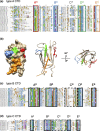A journey with type IX secretion system effectors: selection, transport, processing and activities
- PMID: 37043368
- PMCID: PMC10202324
- DOI: 10.1099/mic.0.001320
A journey with type IX secretion system effectors: selection, transport, processing and activities
Abstract
The type IX secretion system (T9SS) is a multiprotein machine distributed in
Keywords: effectors; gliding motility; protein transport; secretion signal; toxins; type IX secretion.
Conflict of interest statement
The authors declare that there are no conflicts of interest.
Figures




Similar articles
-
The Carboxy-Terminal Region of Flavobacterium johnsoniae SprB Facilitates Its Secretion by the Type IX Secretion System and Propulsion by the Gliding Motility Machinery.J Bacteriol. 2019 Sep 6;201(19):e00218-19. doi: 10.1128/JB.00218-19. Print 2019 Oct 1. J Bacteriol. 2019. PMID: 31262839 Free PMC article.
-
Involvement of the Type IX Secretion System in Capnocytophaga ochracea Gliding Motility and Biofilm Formation.Appl Environ Microbiol. 2016 Jan 4;82(6):1756-1766. doi: 10.1128/AEM.03452-15. Appl Environ Microbiol. 2016. PMID: 26729712 Free PMC article.
-
Flavobacterium gliding motility and the type IX secretion system.Curr Opin Microbiol. 2015 Dec;28:72-7. doi: 10.1016/j.mib.2015.07.016. Epub 2015 Oct 23. Curr Opin Microbiol. 2015. PMID: 26461123 Review.
-
The Type IX Secretion System Is Required for Virulence of the Fish Pathogen Flavobacterium columnare.Appl Environ Microbiol. 2017 Nov 16;83(23):e01769-17. doi: 10.1128/AEM.01769-17. Print 2017 Dec 1. Appl Environ Microbiol. 2017. PMID: 28939608 Free PMC article.
-
Mapping bacterial effector arsenals: in vivo and in silico approaches to defining the protein features dictating effector secretion by bacteria.Curr Opin Microbiol. 2020 Oct;57:13-21. doi: 10.1016/j.mib.2020.04.002. Epub 2020 Jun 5. Curr Opin Microbiol. 2020. PMID: 32505919 Review.
Cited by
-
Phylogenomic characterization of Flavobacterium psychrophilum isolates retrieved from Turkish rainbow trout farms.J Fish Dis. 2025 Aug;48(8):e13961. doi: 10.1111/jfd.13961. Epub 2024 May 22. J Fish Dis. 2025. PMID: 38773965 Free PMC article.
-
Structural and functional insights into the C-terminal signal domain of the Bacteroidetes type-IX secretion system.Open Biol. 2024 Jun;14(6):230448. doi: 10.1098/rsob.230448. Epub 2024 Jun 12. Open Biol. 2024. PMID: 38862016 Free PMC article.
-
The type II secretion system as an underappreciated and understudied mediator of interbacterial antagonism.Infect Immun. 2024 Aug 13;92(8):e0020724. doi: 10.1128/iai.00207-24. Epub 2024 Jul 9. Infect Immun. 2024. PMID: 38980047 Free PMC article. Review.
-
Defining the role of Hmu and Hus systems in Porphyromonas gingivalis heme and iron homeostasis and virulence.Sci Rep. 2024 Dec 28;14(1):31156. doi: 10.1038/s41598-024-82326-6. Sci Rep. 2024. PMID: 39730829 Free PMC article.
-
Structure-function analysis of PorXFj, the PorX homolog from Flavobacterium johnsioniae, suggests a role of the CheY-like domain in type IX secretion motor activity.Sci Rep. 2024 Mar 19;14(1):6577. doi: 10.1038/s41598-024-57089-9. Sci Rep. 2024. PMID: 38503809 Free PMC article.
References
Publication types
MeSH terms
Substances
LinkOut - more resources
Full Text Sources

